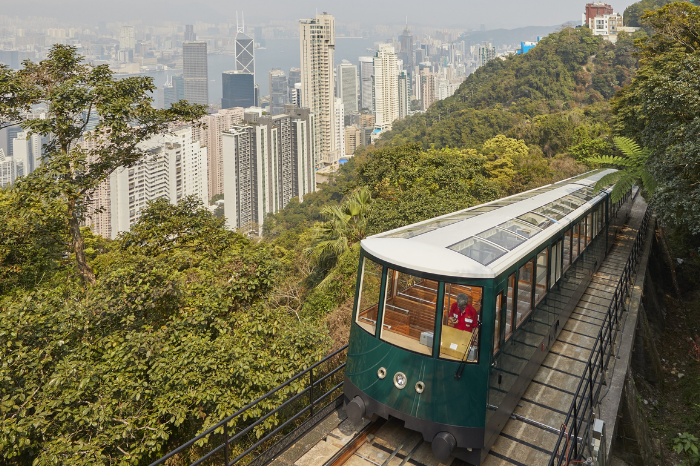
Pulse of the Peak: Chronicling the ascent of Asia’s oldest furnicular
After almost a year of waiting, the sixth generation Peak Tram is set to launch by summer 2022 — trundling up and down the heavily forested slopes of Victoria Peak for 133 years, we look back at colourful history and the old world charm of this meticulously designed modern classic…
Trundling up and down the densely forested slopes of Victoria Peak for 133 years, the tramcar has long been the best way to see the sights from atop, to soak up the panoramic vistas and to absorb the boundless energy of a sleepless city that rises from sea level to Mid-Levels. For generations of families and millions of visitors, doing a weather check and then hopping on Asia’s oldest funicular railway to creak up to the Peak has been a holiday ritual.
Humble Beginnings
Altitude is affluence in Hong Kong. By default, the higher you live, the wealthier you are. Mansions on the elite Victoria Peak make for some of the costliest real estate in the world. In the early years before the Peak Tram was constructed, just 30 or 40 well-heeled British families were in residence. From 1904 for nearly half a century, under a racially discriminatory ordinance passed by the colonial government, Chinese nationals were banned from living there unless they were domestic workers. Once that abhorrent European privilege changed in 1947, navigating the heavily forested slopes of the Peak was unequivocally possible because of the Peak Tram.
Pause for a moment and wonder how the people of the Peak functioned before the tram. With no speeding cars, mass transit system or fossil-fuelled vehicles, hauling up and down that staggering height for an arduous hour or more in sedan chairs, on horses, mules or on foot would undoubtedly have required beastly strength and, in the summer, buckets of sweat.
More of a tourist attraction than a commuter train in today’s world, the Peak Tram climbs the 1.4km from Central in eight to 10 minutes, ascending a dizzying height of almost 400m, and navigating a 27-degree gradient on the most thrilling stretch of its single-track route. It is not only the most efficient route to the top but also the most picturesque. The journey in a boxy, burgundy carriage to the city’s best vantage points is a visual and visceral feast, revealing spellbinding views.
Most of the credit for the gravity-defying funicular goes to an enterprising Scot, Alexander Findlay Smith. A young entrepreneur with a background in railways, Smith arrived in Hong Kong in the 1860s and built the prestigious Peak Hotel atop the Victoria Peak in 1873. Fascinated by the potential of combining rails and wheels, he suggested the ambitious plan for a tramcar to increase trade for his hotel.
Approval for the construction of tracks across the mountainous terrain was granted in 1882, allowing the colossal work of laying track to begin. Machine parts often weighing up to 136kg each were carried uphill by brute manpower. Six years of blood, sweat and tears later, the first generation of the Peak Tram was ready for its inaugural ascent.
Crafted from varnished timber, the car had a seating capacity of 30 passengers; for many years the first two seats were reserved for the Governor of Hong Kong, whose summer house, Mountain Lodge, was then on the Peak. Some 800 passengers rode the tram on the first day, and 150,000 in the first year – to put this number into perspective, in 1888 that was the entire population of Hong Kong.
A Slice of History
A revolutionary feat of engineering for a genius mode of transport, the first Peak tramcars were powered by coal-fired steam. The original price for a first-class ride was 30 cents, with 20 cents for second-class seats and 10 cents for third class, and tickets for the return journey slashed by half. At the last count this year, a single ticket was HK$37, thousands of times higher than the early fare, but only the cost of a Starbucks latte for a vintage Hong Kong experience.
The nostalgic, colonial vibe of the tramway, with its characteristic wooden benches, hasn’t really changed in 133 years, nor indeed the necessity of queuing for hours at peak times to board a crammed carriage. But in tandem with the extraordinary vertical growth of the majestic city skyline, the technology and structure of the funicular itself has undergone a series of makeovers since it first set wheels on the hilly terrain. The power system switched to electric in 1926; the tramcars began their shift from wood to metal in 1948; and the colour of the carriages went from deep red to green and then back to burgundy. Since the fifth-generation Peak Tram (car capacity: 120) was rolled out in 1989, it has carried some 140 million people up and down for day trips, evening dinners and scenic strolls around the summit.
A Tramcar Called Nostalgia
A further, highly anticipated modernisation has been underway. The massive HK$700 million facelift during the last eight months will reveal a passenger-capacity uptick to 210 and a weekend waiting-time cut from 90 minutes to a mere 17 minutes. The upper and lower terminuses will be extensively renovated to accommodate the bigger cars, and the control and signalling systems completely overhauled.

An emblem of Hong Kong, the Peak Tram has withstood the ruins of the Second World War, survived epic hillside floods and braved the current pandemic. Before 2019, it recorded an annual ridership of six million – roughly 17,000 passengers a day – and even during the peak of Covid-19, patronage stood steady at one million. It’s one of the oldest forms of public transport and a slice of local history.
Owned by the Hong Kong and Shanghai Hotels since 1971, the tramway is a landmark in the same ilk as the group’s grand-dame property, The Peninsula Hong Kong. It takes a place of pride in Hongkongers’ hearts. Hundreds of people queued for hours to ride in those iconic burgundy carriages one last time before the service closed at the end of June.
In a futuristic megapolis, the humble carriages of the Peak Tram are a reminder of the contrasts that define Hong Kong – of old and new, gritty and glossy – and they serve as a social bridge between the rich and the poor. Yes, you can whoosh to the top of the Peak in your Ferrari, but is it as enriching as chugging up in an ancient time capsule, wind caressing the hair as you reminiscence about the first tram journey you took as a child? The 10-minute ride to the top brings awe and perspective, changing more than just how you travel.
(Text: Nikita Mishra)













